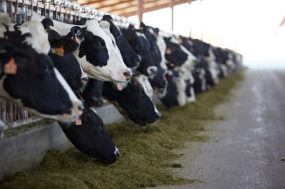According to the authors, researchers from the University of Alberta, feedomics is an emerging field that integrates a range of “-omics” technologies (e.g., genomics, epigenomics, transcriptomics, proteomics, metabolomics, metagenomics and metatranscriptomics).
They said the ability to collect large sets of complex data about different aspects related to cows provides new opportunities to better understand the mechanisms regulating cow performance. The integration of all these different technologies will allow us to identify the best strategies to improve overall animal productivity, product quality, welfare and health.
The article is a review of the outcomes of the most recent research of these different -omics technologies applied to dairy cows, and it highlights how an integrated feedomics approach could be applied in the future to improve dairy cow production and health. They focus the results on two main topics: improving milk yield and milk quality, and understanding metabolic physiology in transition dairy cows.
The authors said that, although the research community has begun to collect large amounts of complex data to address different aspects related to dairy production (methane emissions, enhanced immune response, hoof health, heat stress tolerance, etc.), most studies only focus on a single -omics technology. They refer to each -omic approach as a “layer” of information, which usually misses important information from other biological layers as well as the interaction between different layers.
As such, these data may not contribute sufficiently to our understanding of biological or pathological phenomena to be converted into valuable knowledge and new applications. This is where feedomics can help, by collecting and analyzing in an integrated way all the -omics data from different sources.
“Does blending canola meal with other protein sources improve production responses in lactating dairy cows? A multilevel mixed-effects meta-analysis.” Journal of Dairy Science Vol. 102 No. 6, 2019. This is an interesting paper by researchers from Laval University and Agri-Food Canada in Quebec trying to evaluate the effect of canola meal when blended with other protein sources on production responses on dairy cows. Traditionally, canola co-products didn’t have the best reputation as a feed for dairy cows because of having a high concentration of certain components that negatively affected dry matter intake and milk production.
The authors said in the 1970s, Canadian producers developed varieties of Brassica spp. with low concentrations of erucic acid (less than 2%) in the oil and glucosinolates (less than 30 micromoles per gram) in the defatted meal. (According to the Canola Council of Canada, canola belongs to the Brassica genus, the botanical family that includes cauliflower and cabbages. The name canola is a contraction of Canada and ola, meaning oil.) These varieties are named “canola” in North America and “zero-zero,” “double-zero” or “double-low” rapeseed in Europe.
Over the last four decades, several trials using canola in dairy diets have been done. These studies used canola meal as the sole protein source, or canola compared with other protein sources. They indicated that canola could be fed as freely to cows as soybean meal (up to 4.1 kilograms per day) and that milk composition was equally satisfactory from either feed. In all these studies, due to the nature of the trials, the datasets did not include studies in which canola meal was blended with another protein source (for example, 50-50 for soybean meal and canola meal).
It is often recommended to blend different protein sources to try to achieve the best amino acid profile supply and avoid limitation on some essential amino acid, so the authors wanted to know if the productive response by using canola would be the same if using canola meal as the only source of protein as compared to blended with other protein sources.
The question was to know if canola response is linear or quadratic, meaning that if the response is linear, canola meal can be added until protein needs are met and there won’t be justification to use blends other than price-related. If, on the other hand, the response is quadratic, it would mean that as we increase the amount of canola meal in a diet, the response improves up to a certain level and then starts to decline, suggesting issues related to nutrition and quality of canola meal as a protein source.
All the diets on the studies analyzed were isonitrogenous diets, meaning that when comparing diets with different protein sources, the diets were balanced for the same crude protein content. The meta-analysis included studies with at least three or more dietary treatments, and with isonitrogenous diets, and covered four decades of research. The results indicated that only responses in milk true protein concentration were related quadratically to the supply of crude protein from canola meal (meaning that as canola meal increased, the marginal increase in true milk protein decreased).
Other types of responses, like dry matter intake and production, were related linearly and positively to the supply of crude protein from canola meal. Based on this analysis, and within the limits of the data available, the authors concluded that the study does not support the idea that blending canola meal with other protein sources will outperform the positive production responses obtained by supplementing crude protein from canola meal alone up to 1.55 kilograms per day. (This amount of crude protein from canola meal would represent around 4.2 kilograms of canola meal per day.) ![]()
This column brings you information regarding some of the research being done around the world and published in the Journal of Dairy Science. The objective is to bring to light areas of research that may have an immediate practical application on a dairy farm, as well as research that, even though it may not have a practical impact now, could be interesting for its future potential application. The idea is to give a brief overview of select research studies but not go into detail on each topic. Those interested in further in-depth reading can use the citations to find each study.

-
Pedro Nogueira
- Nutritionist
- Shur-Gain
- Email Pedro Nogueira









